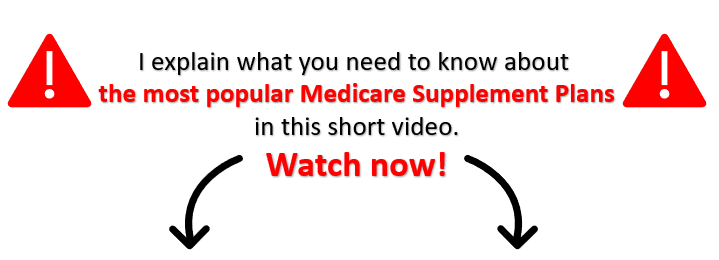What are Medicare Supplement Plans?
Medicare Supplement Plans, also called Medigap policies, are plans offered by private insurers. These plans are meant to decrease the out-of-pocket expenses of Original Medicare. While the plans are all offered by different insurers, they are all based on templates laid out by the federal government in accordance with state law. There are ten templates in total. Today, we’ll talk about the three best templates and how to choose between them.


Types of Medicare Supplement Plans
The plan types are:
- Plan A
- Plan B
- Plan C
- Plan D
- Plan F
- Plan F with High Deductible
- Plan G
- Plan G with High Deductible
- Plan K
- Plan L
- Plan M
- Plan N
Some states, including Massachusetts, Minnesota, and Wisconsin have different plan templates.
Let’s compare the plans to each other.
Medigap Policy Comparison
Medicare Part A Coinsurance and Hospital Costs
- Plan A – 100%
- Plan B – 100%
- Plan C – 100%
- Plan D – 100%
- Plan F – 100%
- Plan G – 100%
- Plan K – 100%
- Plan L – 100%
- Plan M – 100%
- Plan N – 100%
Medicare Part B  Coinsurance or Copayment
Coinsurance or Copayment
- Plan A – 100%
- Plan B – 100%
- Plan C – 100%
- Plan D – 100%
- Plan F – 100%
- Plan G – 100%
- Plan K – 50%
- Plan L – 75%
- Plan M – 100%
- Plan N – 100%
First 3 Units of Blood
- Plan A – 100%
- Plan B – 100%
- Plan C – 100%
- Plan D – 100%
- Plan F – 100%
- Plan G – 100%
- Plan K – 50%
- Plan L – 75%
- Plan M – 100%
- Plan N – 100%
Skilled Nursing Facility Care Coinsurance
- Plan A – 0%
- Plan B – 0%
- Plan C – 100%
- Plan D – 100%
- Plan F – 100%
- Plan G – 100%
- Plan K – 50%
- Plan L – 75%
- Plan M – 100%
- Plan N – 100%
Part A Deductible
- Plan A – 0%
- Plan B – 100%
- Plan C – 100%
- Plan D – 100%
- Plan F – 100%
- Plan G – 100%
- Plan K – 50%
- Plan L – 75%
- Plan M – 50%
- Plan N – 100%
Part B Deductible
- Plan A – 0%
- Plan B – 0%
- Plan C – 100%
- Plan D – 0%
- Plan F – 100%
- Plan G – 0%
- Plan K – 0%
- Plan L – 0%
- Plan M – 0%
- Plan N – 0%
Part B Excess Charges
- Plan A – 0%
- Plan B – 0%
- Plan C – 0%
- Plan D – 0%
- Plan F – 100%
- Plan G – 100%
- Plan K – 0%
- Plan L – 0%
- Plan M – 0%
- Plan N – 0%
Foreign Travel Emergency
- Plan A – 0%
- Plan B – 0%
- Plan C – 80%
- Plan D – 80%
- Plan F – 80%
- Plan G – 80%
- Plan K – 0%
- Plan L – 0%
- Plan M – 80%
- Plan N – 80%
Out of Pocket Limit (2020)
- Plan A – No limit
- Plan B – No limit
- Plan C – No limit
- Plan D – No limit
- Plan F – No limit
- Plan G – No limit
- Plan K – $5880
- Plan L – $2940
- Plan M – No limit
- Plan N – No limit
Plans F and C are no longer offered to people who are newly eligible for Medicare beginning January 1, 2020.
Additionally, Plans F and G also offer high deductible plans in some states. These high deductible options are otherwise identical in coverage to their original counterparts.
Lastly, Plan N pays only a portion of the Part B coinsurance. You still have to pay a copayment of up to $20 for office visits and up to $50 for emergency room visits that don’t result in an inpatient admission

Best Plans for their Value
Taking a look at the information above, Plan G, Plan G High Deductible (GHD), and Plan N are the best plans. In the end, it comes down to cost.
Plan G and High Deductible Plan G are the most comprehensive plans. They don’t cover the Part B deductible, but the Part B deductible is only $198 annually. Plan G and GHD also cover important extras, like Emergency foreign travel coverage. Plan GHD has a much lower premium than Plan G but a high deductible ($2340 annually). Depending on the monthly premiums in your area, this high deductible in exchange for a lower premium may be worth it.
Plan N is also a great plan. It often has a lower premium than other plans because it requires certain co-pays. Specifically, it costs $20 for a doctor visit and $50 for ED visits. Plan N is most different from Plan G in that Plan N does not cover Medicare excesses. Some states allow Medicare to be reimbursed at 15% above its agreed value for certain services. That is called a Medicare excess. Under Original Medicare, there are certain times you would be required to pay that 15% difference. However, some states don’t allow excess charges (Vermont, Ohio, New York, Rhode Island, Minnesota, Massachusetts, Connecticut, Pennsylvania). If you live in one of these states, Plan N should be just as attractive as Plan G and GHD.
When to Choose Each Plan
So we know that Plan G, GHD, and Plan N are the most comprehensive plans. But how do you choose between them? It all boils down to the premium. The premium for each plan will be different based on your area and insurance company. We’ve developed a simple guide to help you through the decision making process.
When to choose plan G?
If the premium is affordable Gold standard
Full coverage
When to choose plan N?
Affordable premium (if it’s like $25 less than G) If you live in a state with no excess charges
When to choose Plan GHD?
If Plan G premium is over 180
States w/ long year-long open enrollment
Still Have Medicare Questions?
Medicare Supplement Plans can help decrease your out-of-pocket costs of Original Medicare. There are ten different templates. The best value templates are Plan G with and without the deductible and Plan N. The monthly premium will dictate which of these you should buy. At Medicare On Video, we specialize in Medicare Supplement Plans. Call us today to learn more about your supplement options.

















